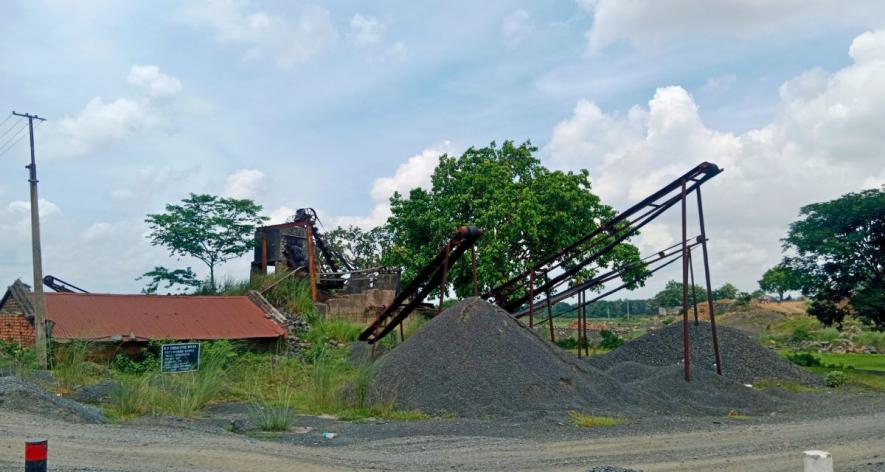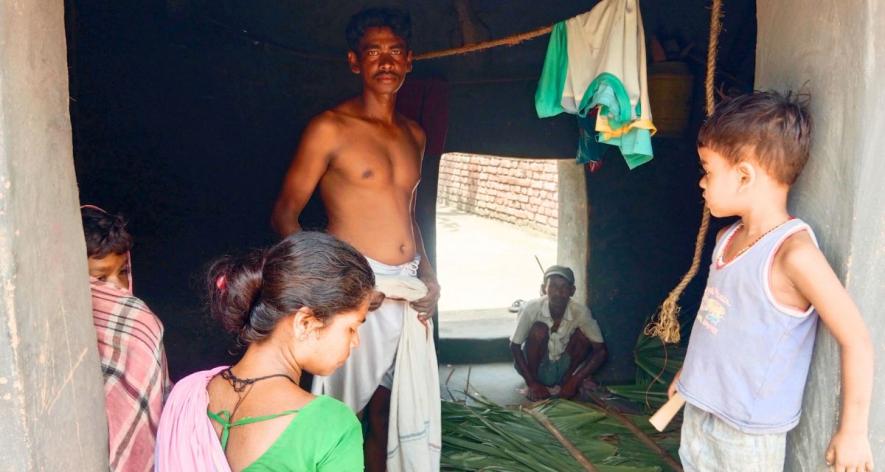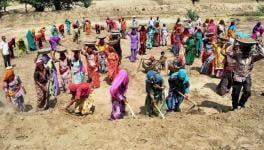Mechanisation, Shutting Down of Stone Quarries Push Pakur's Workers to the Brink

Pakur, Jharkhand: These days, Gayna Murmu (28) gets work every second day only. He levels the stones loaded on trucks and tractors to earn Rs 200 to 300. Gayna Murmu and his wife Lukhi Tudu have seven children, and they find it difficult to survive due to the low availability of work in the stone industry. They do not have agricultural lands to cultivate, which adds to the uncertainty.
"Our ration card was in the name of my father, Som Murmu. He died six months ago, after which we did not get ration supplies. The card is yet to be transferred to my name. It involves spending some money," said Gayna, who lives in Pipaljori village in Nabinagar panchayat in the Malpahari area of Pakur district.
Located in the northeast region of Jharkhand, Pakur has a tribal population of 42.1%. The state government controls the mining activities here as the stone excavation comes in the category of minor minerals.
Both Pakur and its neighbouring Sahibganj are important centres of stone mining and its business in eastern India. Most part of the Rajmahal hills, which are among the oldest mountain ranges of the country, fall under the Sahibganj district, and some areas fall under Pakur.
The black stones quarried from Pakur are famous for their export quality. Large-scale stone quarrying happens in all its six blocks, but Malpahari has been one of the overexploited areas.
Excessive mining has left huge pits similar to those seen in coal mines in some villages. Vector-borne diseases are common here. "People die suddenly. We were 12 brothers and sisters, now only four are alive," said a stone worker from Pipaljori village on condition of anonymity.
"When a brother fell ill this year, we took him to Rampurhat in West Bengal. The doctor there told us to take him to Bardhaman, but by then, he died," the villager said.
Machines Take Away Workdays
According to information received from the District Mining Department, Pakur received a revenue of Rs 117 crore from stone quarrying in 2022-23 and Rs 78 crore in 2021-22. District Mining Officer Pradeep Kumar Sah told 101Reporters that Pakur has around 80 active stone mining leases. There are about 100 to 125 crushers in operation against the earlier 400 to 500.
Nabinagar panchayat head Manoj Kisku (26) told 101Reporters that the mines have been closing down over the last seven years.
"People were staying here because of the mines. Ever since the COVID-19 lockdown, the loss of employment in stone mines and crushers has increased. That apart, the Enforcement Directorate is investigating a stone mining scam, which has impacted the workdays."
Kisku claimed that 40% of the people, mostly tribals, have migrated from his panchayat. Talking about his village, he said 65-70% of the people in Pipaljori have been affected, and 75% of the young boys have gone out to earn.
"People have left for Kolkata, Bardhaman and Hyderabad. Also, contractors take labourers from this area for three months to do farming in other parts of West Bengal," he added.
Pakur Labour Superintendent Ramesh Prasad Singh told 101Reporters that 50,000 unorganised sector workers were registered with the labour department in the district. Asked about women workers, he said the registration was not based on gender, so it was difficult to tell their percentage.
"It may also be a little difficult to assess how many people work in the stone industry at present because it is not necessarily the same as its labour capacity. Even if a crusher has a licence with a labour capacity of 50 workers, it is possible that only 10 people work there," he explained, while not divulging the exact number of workers who migrated from here.

As of October 2, the e-shram portal has 2,85,696 registered workers in Pakur. A maximum number of 1,84,622 work in the agricultural sector, followed by 32,079 in domestic and household work, 24,809 in the tobacco industry, 10,902 in the construction sector and 6,015 in capital goods and manufacturing. There is no separate category for stone mining, which shows its workers are counted along with other sectors.
The Pachhwara North Coal Mine in Pakur district supplies coal to the power plants of West Bengal. Coal mining provides less employment because it is centralised and mechanised, whereas stone mining takes place throughout the district and involves small and medium units.
Asked about the decreasing employment prospects in stone mining units, Pakur District Mining Officer Pradeep Kumar Sah told 101Reporters that mining was done with automatic machines. "Now, even five to seven labourers can run a crusher, for which earlier 20 to 25 people were required."
Migration of workers from Jharkhand is high, so the state government records their details. According to the labour department data, there are 12,482 registered migrant workers in the Pakur district.
As of October 3, Pakur district has 1,15,036 active workers under the Mahatma Gandhi National Rural Employment Guarantee Act (MGNREGA) scheme, including 52,229 women. As many as 41,153 workers are from the Scheduled Tribes category and 3,080 from the Scheduled Castes category. However, the definition of active worker in MGNREGA has a very broad context, including any worker or his family member who has worked for a single day in the last three years.
Pakur Deputy Development Commissioner Shahid Akhtar told 101Reporters that MGNREGA created employment in the district. "During rainy days, construction-related schemes are operated, while pond/well works and similar activities are run at other times. However, this district is still heavily dependent on mining for revenue and employment," he said.
Pakur's MGNREGA ombudsman Vinod Kumar Pramanik said there was a possibility of MGNERGA labourers going for work in stone crushers as the scheme guaranteed only 100 days of employment in a year.
Mining Laws Bypassed
A 2017 order from the state government banned mining on government land. Now, it is done only on rayati lands, and the district magistrate or deputy commissioner has the authority to auction land measuring up to three hectares (7.41 acres) for stone mining.
Asked about excessive mining in Malpahari, District Mining Officer Sah said, "Earlier, there was no pre-decided mining volume; maybe that is why you feel there has been excessive mining. However, after the Jharkhand Minor Mineral Concession (Amendment) Rules, 2014, scientific mining has been promoted. Now, only a fixed quantity can be mined from a particular place," he said.
After 2010, the Jharkhand government has made rules from time to time and has tried to organise them. A forest department official related to this process in Pakur district said excessive and unscientific mining has taken place in Malpahari. "Rules and guidelines are not followed, and no concrete action has been taken to enforce them. We have only limited rights in this process. The Jharkhand Pollution Control Board should actively intervene," he said on condition of anonymity.
On the question of compensation for the loss caused to the district due to excessive mining, Pakur Divisional Forest Officer Rajneesh Kumar told 101Reporters that a plantation of 7.5 m width has to be done in the perimeter around the stone mining as per the rule. "Five to 10 times the number of trees cut for mining has to be planted or transplanted as per the requirement. A high power committee of Jharkhand High Court meets in this regard from time to time, and its recommendations keep coming," he said.
"The stone mines in Pakur district are not on any forest land. Hence, we do not directly intervene there. However, there is a coal mine on the forest land, and we intervene there and get the plantation done," Kumar said.
The forest department's data suggest that 1,50,718 saplings were planted on roadsides in Pakur district in the 2022-23 fiscal, while a target has been set at 2,90,350 saplings in the present one. However, due to insufficient rainfall, the work has been affected. Kisku, however, alleged that the plantation was just an eyewash as the mining companies do not check on the condition of the saplings once they are planted.
(Rahul Singh is a Jharkhand-based freelance journalist and a member of 101Reporters, a pan-India network of grassroots reporters.)
Get the latest reports & analysis with people's perspective on Protests, movements & deep analytical videos, discussions of the current affairs in your Telegram app. Subscribe to NewsClick's Telegram channel & get Real-Time updates on stories, as they get published on our website.
























